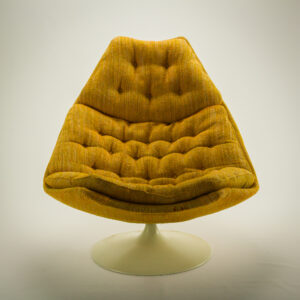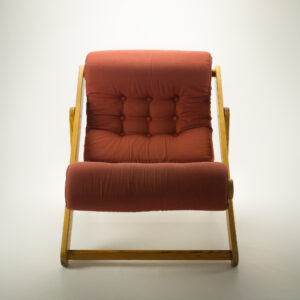El Lissitzky model D61 fauteuil for Tecta set/2
El Lissitzky designed the D61 armchair in 1930. This set of 2 identical branded chairs was made in Germany by Tecta in the 1970s. This makes it a timeless design. El Lissitzky designed the portable plywood model D61 for the Hygiene exhibition in Dresden. The exhibition was a specialty and fell under the responsibility of the then director of the Hygiene Museum. Tecta bought the rights to the design and started producing the chair. This set is unique and special! El Lissitzky (Pochinok, Russia, 1890 – Moscow, 1941), was a Russian Jewish artist, painter, graphic artist, architect, typographer and photographer. He was one of the leading artists in the Russian avant-garde of the early 20th century. Together with his friend and mentor Malevich, he developed Suprematism from Cubism and Futurism. His work has had a major influence on constructivism, Bauhaus and De Stijl. He grew up in Vitebsk in what is now Belarus. In his teens he was taught by Jehuda Pen, a local Jewish artist. He was a fast learner and soon began teaching himself. In 1909 he was rejected by the St. Petersburg Art Academy because of the numerus clausus that applied to Jewish students under the Tsarist regime. In order to be able to study, Lissitzky left for Germany where he studied architecture at the Darmstadt University of Technology. With the outbreak of the First World War he had to return to Russia. In Moscow he graduated in architecture and started working in that field. With the fall of the Tsar’s regime, an era with unprecedented new possibilities began for Lissitzky, as well as for other young Jewish artists. In 1919 Marc Chagall invited him to work at the Folk Art School in Vitebsk. He focused on developing geometric shapes. This was followed by the founding of Unovis, the ultimately short-lived but highly influential think tank of suprematism. The group in which Lossitzky developed ensured the spread of supremacist ideas and made Lissitzky one of the best-known unovists. At that time, Lissitzky also developed his own supremacist style, which he called PROUN. He himself described it as “the stage where someone turns from painting to architecture”. Suprematism takes painting from the state of the ancient named concrete number to the modern abstract number, which is purely objective, which is a number that by its nature takes its place next to all objects. The artist constructs a new symbol with his brush. This symbol is not a recognizable form of something that is already finished, that has already been created, or that is already present in the world. It is a symbol of a new world built on and existing in the way of the people. In 1921 Lissitzy left Vitebsk and became a cultural attaché in Berlin. Here he had to establish contacts between Russian and German artists. He worked as a writer and designer for international magazines and helped the avant-garde to become known through exhibitions in galleries. In Berlin he met and befriended many artists, including Kurt Schwitters, László Moholy-Nagy, Mart Stam and Theo van Doesburg. With Schwitters and Van Doesburg he worked on the idea of an international artists’ movement according to the guidelines of constructivism. Via Van Doesburg the bridge was created with styles such as Bauhaus and De Stijl. With Schwitters he filled an issue of the magazine Merz. Schwitters introduced Lissitzky to the Kestner Gesellschaft gallery in Hannover, where he had his first solo exhibition. The second PROUN series, printed in Hannover in 1923 with new techniques, became a great success. In Hannover he also met Sophie Kuppers, whom he would marry in 1927. In 1924, Lissitzky went to Switzerland for treatment of his tuberculosis. He financed his stay there by designing advertising for Pelikan Industries, he translated articles by Malevich into German and he experimented with typography and photography. Recovered, Lissitzky left for Moscow in 1925 where he started teaching interior design and architecture. He also focused on designing contributions to exhibitions. His contribution to the Polygraphic Exhibition in Moscow in 1927 was notable, which would earn him a large number of follow-up commissions. Lissitzky continued to design for exhibitions; he designed, among other things, the Russian contribution to the 1939 World Exhibition in New York. He also experimented extensively with printing. He was perhaps most influential in that area, he designed new techniques for typography and photomontage. He also continued to design Soviet propaganda material. He worked for a while for the propaganda magazine USSR im Bau. Some of his most notable efforts in book design have been published there. In 1941 he became ill again, and on December 30 he died of tuberculosis.









